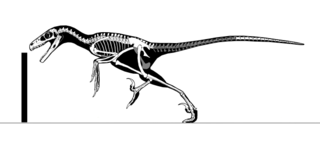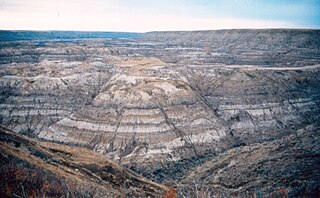Related Research Articles

The Royal Tyrrell Museum of Palaeontology is a palaeontology museum and research facility in Drumheller, Alberta, Canada. The museum was named in honour of Joseph Burr Tyrrell, and is situated within a 12,500-square-metre-building (135,000 sq ft) designed by BCW Architects at Midland Provincial Park.

Saurornitholestes is a genus of carnivorous dromaeosaurid theropod dinosaur from the late Cretaceous of Canada (Alberta) and the United States.

Dinosaur Provincial Park is a UNESCO World Heritage Site situated a two hour drive east of Calgary, Alberta, Canada; or 48 kilometres (30 mi), about a half-hour drive northeast of Brooks.

Pachyrhinosaurus is an extinct genus of centrosaurine ceratopsid dinosaur from the Late Cretaceous period of North America. The first examples were discovered by Charles M. Sternberg in Alberta, Canada, in 1946, and named in 1950. Over a dozen partial skulls and a large assortment of other fossils from various species have been found in Alberta and Alaska. A great number were not available for study until the 1980s, resulting in a relatively recent increase of interest in Pachyrhinosaurus.

Barnum Brown, commonly referred to as Mr. Bones, was an American paleontologist. Named after the circus showman P. T. Barnum, he discovered the first documented remains of Tyrannosaurus during a career that made him one of the most famous fossil hunters working from the late Victorian era into the early 20th century.

The Horseshoe Canyon Formation is a stratigraphic unit of the Western Canada Sedimentary Basin in southwestern Alberta. It takes its name from Horseshoe Canyon, an area of badlands near Drumheller.

Midland Provincial Park is a provincial park located in Alberta, Canada.
Charles Mortram Sternberg (1885–1981) was an American-Canadian fossil collector and paleontologist, son of Charles Hazelius Sternberg. Late in his career, he collected and described Pachyrhinosaurus, Brachylophosaurus, Parksosaurus and Edmontonia. A contemporary author wrote, "No published study of Canadian dinosaurs is possible today without citing one or another of Sternberg's papers."

The "World's Largest Dinosaur" is the name of a roadside tourist attraction in the form of a model Tyrannosaurus rex located in the Town of Drumheller, Alberta, Canada. The World's Largest Dinosaur is one of several dinosaur-related attractions in the Town of Drumheller and the surrounding areas, which includes Dinosaur Provincial Park.
Darren H. Tanke is a Canadian fossil preparation technician of the Dinosaur Research Program at the Royal Tyrrell Museum of Palaeontology in Drumheller, Alberta. Born in Calgary, Tanke became interested in natural history at an early age. In 1979, Tanke began working for Philip J. Currie in the paleontology department of the Provincial Museum of Alberta, originally as a volunteer. From 1979 until 2005 Tanke worked as a lab and field technician, a job he still holds today.
Wann Langston Jr. was an American paleontologist and professor at the University of Texas at Austin.
Paleontology or palaeontology is the study of prehistoric life forms on Earth through the examination of plant and animal fossils. This includes the study of body fossils, tracks (ichnites), burrows, cast-off parts, fossilised feces (coprolites), palynomorphs and chemical residues. Because humans have encountered fossils for millennia, paleontology has a long history both before and after becoming formalized as a science. This article records significant discoveries and events related to paleontology that occurred or were published in the year 1912.
Paleontology or palaeontology is the study of prehistoric life forms on Earth through the examination of plant and animal fossils. This includes the study of body fossils, tracks (ichnites), burrows, cast-off parts, fossilised feces (coprolites), palynomorphs and chemical residues. Because humans have encountered fossils for millennia, paleontology has a long history both before and after becoming formalized as a science. This article records significant discoveries and events related to paleontology that occurred or were published in the year 1913.
Paleontology or palaeontology is the study of prehistoric life forms on Earth through the examination of plant and animal fossils. This includes the study of body fossils, tracks (ichnites), burrows, cast-off parts, fossilised feces (coprolites), palynomorphs and chemical residues. Because humans have encountered fossils for millennia, paleontology has a long history both before and after becoming formalized as a science. This article records significant discoveries and events related to paleontology that occurred or were published in the year 1919.
Paleontology or palaeontology is the study of prehistoric life forms on Earth through the examination of plant and animal fossils. This includes the study of body fossils, tracks (ichnites), burrows, cast-off parts, fossilised feces (coprolites), palynomorphs and chemical residues. Because humans have encountered fossils for millennia, paleontology has a long history both before and after becoming formalized as a science. This article records significant discoveries and events related to paleontology that occurred or were published in the year 1935.
Paleontology or palaeontology is the study of prehistoric life forms on Earth through the examination of plant and animal fossils. This includes the study of body fossils, tracks (ichnites), burrows, cast-off parts, fossilised feces (coprolites), palynomorphs and chemical residues. Because humans have encountered fossils for millennia, paleontology has a long history both before and after becoming formalized as a science. This article records significant discoveries and events related to paleontology that occurred or were published in the year 1937.
Eugene S. Gaffney is an American paleontologist and leading authority on the morphology and evolutionary history of turtles.

Spinops is an extinct genus of centrosaurine ceratopsian dinosaur from the Late Cretaceous of Alberta, southern Canada. It was a medium-sized ceratopsian, reaching 4.5 metres (15 ft) in length and 1.3 metric tons in body mass.

Apatoraptor is a genus of caenagnathid dinosaur which contains a single species, A. pennatus. The only known specimen was discovered in the Campanian-age Horseshoe Canyon Formation of Alberta.
The China-Canada Dinosaur Project was a six-year series of palaeontological expeditions carried out by scientists from China and Canada.
References
- 1 2 3 4 5 6 "Jane Colwell-Danis | TrowelBlazers". trowelblazers.com. Retrieved 2015-10-14.
- ↑ Tanke, Darren H. "Remember me: Irene Vanderloh (1917-2009): Alberta's first woman amateur vertebrate paleontologist". www.academia.edu. Retrieved 2015-10-14.
- ↑ Currie, P.J., and Koppelhus, E.B. (eds). 2005. Dinosaur Provincial Park: A Spectacular Ancient Ecosystem Revealed. Indiana University Press: Bloomington and Indianapolis, p.16
- ↑ Victoria, Herridge (2015-04-10). "Jane Colwell-Danis was the first female vertebrate..." scholar.aci.info. Retrieved 2015-10-14.